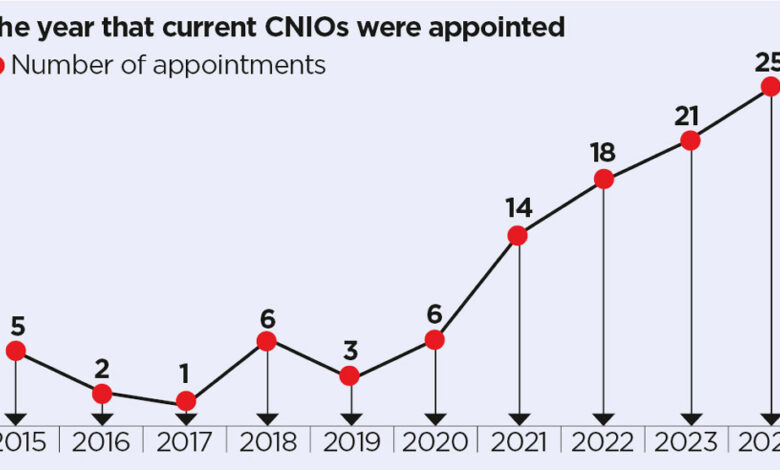Revealed: the current picture of digital nursing leadership

There has been a natural evolution towards digitising NHS services over the last few decades.
Technology has gradually embedded itself in nursing and midwifery practice, offering new opportunities for patient diagnosis, treatment and care.
With this great digital transformation comes a great responsibility, to ensure that the healthcare workforce is confident at utilising these technologies and, most importantly, that nobody is left behind.
This is where the chief nursing information officer (CNIO) role has emerged.
CNIOs play a crucial role in bridging the gap between the workforce and the digital technologies that are being introduced.
These digital nurse leaders design, implement and adjust digital systems in clinical settings, and train new users of these systems.
In addition, they assess the potential risks that come with new technology, ensuring that all innovation is introduced with patient safety in mind.
In 2024, CNIOs have become central figures in championing digital transformation across the NHS, but there have been disparities in the rolling out of the role across the country.
A major new Nursing Times investigation has set out what the current landscape of digital nurse leadership looks like. It has uncovered how many CNIOs are working across England and also where they are still missing.
It comes as the former chief nursing officer for England, Dame Ruth May, pledged in 2022 that all healthcare organisations should have a CNIO.
This was then reiterated by the national CNIO for England, Helen Balsdon, earlier this year.
She called for there to be digital nurse leaders in all places of care and for there to be “fresh faces” in the space. She also noted the importance of having “diversity across our [CNIO] networks”.
Under the Freedom of Information Act, Nursing Times asked every NHS trust in England to confirm whether they had a CNIO and, if so, provide details on the year they were appointed, what Agenda for Change band they worked at and whether they came from a minority ethnic background.
The data, provided by 197 trusts, revealed that 125 organisations have a CNIO in post, while 72 do not.
The investigation found an increase in appointments over the last nine years, with a particular surge following the Covid-19 pandemic.
While the figures only relate to when the trust appointed its current CNIO, rather than its first, the newness of the role means that most will probably be first-time appointments.
The year that saw the most appointments for CNIOs was 2024, with 25 individuals being brought into post over the last 10 months.
Some appointments were so recent that they have come just weeks before the publication of this investigation, with two trusts appointing their current CNIOs near the end of September.
At the time of writing, five trusts also reported that they were currently recruiting a CNIO.
The data revealed that the earliest year that a trust recruited its current CNIO was 2015.
Five individuals were appointed that year and continue to remain in post almost a decade later.

Ian Coe, CNIO for West Suffolk NHS Foundation Trust, is one of these individuals.
Mr Coe noted that many of the earlier CNIO appointments coincided with NHS trusts rolling out their electronic patient record (EPR) system.
NHS England has a target for all trusts to have a working EPR system by March 2025.
“Every EPR procurement [and] roll-out seems to grow even more. It’s good that nursing has got a voice in this, because when I started this it wasn’t the case,” he said.

Ian Coe
“It was growing but it was in its infancy. The systems were developed primarily by doctors, for doctors.”
While the CNIO role has nursing in the title, often it encompasses professions beyond nursing.
Several respondents to the Freedom of Information request explained that their CNIO also covered midwifery and allied health professions (AHPs).
In addition, some favoured the title chief x information officer to reflect the multidisciplinary approach needed for digital transformation.
Mr Coe noted this, and said the role was “morphing into something” broader, where nurses were becoming responsible for overseeing digital transformation across all the NHS professions.
Separately, the Nursing Times investigation uncovered wide variation around the level at which CNIOs are working and being paid.
The most common Agenda for Change banding for CNIOs was 8b and 8c, with 26 individuals working at each of these levels, respectively.
However, the data showed that CNIOs were working from anywhere between band 7 to band 9, while some were even working at ‘very senior manager’ level.

The national CNIO for England warned of this variation earlier this year at the Digital Health Rewired 2024 conference.
At the time, Ms Balsdon argued that it showed that nobody was “really clear about what a digital nurse or midwife leader is”.
The Phillips Ives Review also warned that there was great variation in the way that digital specialists were remunerated for their work.
The long-awaited review into the digital readiness of nurses and midwives is still awaiting publication by NHS England, but Nursing Times has seen a leaked version.
As well as “variation in the level of seniority and remuneration”, the review warned that while international recruitment initiatives were bringing a culturally diverse workforce to the healthcare system, the lack of equitably accessible career pathways into digital meant this staff group would be less likely to be appointed to digital specialist roles.
Lack of diversity in the CNIO roles across England is something that has stood out in this investigation.
First, men are seemingly overrepresented, holding the role in a quarter of the 106 trusts that identified the individual working in the post. This is despite men making up just 11% of the nursing and midwifery workforce overall.
Nursing Times also requested ethnicity data for all the CNIOs in England.
Some 75 trusts withheld this information, making it difficult to build a comprehensive picture of just how diverse this workforce is.
However, out of the 50 trusts that provided the data, just eight said their CNIO came from a minority ethnic background.
Sarah Amani, CNIO at Dorset Healthcare University NHS Foundation Trust, said progress to ensure diversity in these senior digital nursing positions over the last decade had been “very slow”.
Ms Amani was the first Black female chief clinical information officer to be appointed in the UK back in 2011.
Regarding our findings, she argued that if all the NHS trusts had given data on ethnicity, then the percentage of those who came from a minority ethnic background would be “much lower”.
Ms Amani told Nursing Times that representation in digital nursing roles “really matters”.
“It’s important because we bring a perspective that’s necessary to serve the diversity of our populations, but also our workforce,” she said.
Meanwhile, she added that she was surprised that 72 trusts in England still did not have a CNIO role at all.

Sarah Amani
Ms Amani argued that it was a “false economy” for trusts to not invest in digital nurse leadership and warned that the cost of not doing so could be great.
She said: “I think as soon as you mention digital, people think of [it as] ‘nice to have’, like a luxury [or] like a fancy toy.
“But for me, I look at it as a patient safety role.
“If you don’t have that dedicated role, you’re missing a very significant and crucial piece of intelligence to inform your decisions. I do hope those 72 trusts would reconsider.”
Ms Amani is one of the founders of the Shuri Network, which supports women health workers from minority ethnic backgrounds to develop their digital skills and pursue a career in the specialism.
To date, the group has amassed more than 2,400 members and allies, and has gathered the support of NHS England.
The group was formed after Ms Amani was contacted by GP and then chief medical officer for NHS Digital, Dr Shera Chok, back in 2019.
The pair concluded that, over the previous decade, “nothing had changed” in terms of the diversity of people undertaking digital health leadership programmes.
“It was like only a certain type, and typically a White male, would be able to get into a digital realm and senior role,” she explained.
The Shuri Network launched a digital fellowship programme in partnership with NHS England, to provide coaching sessions and peer support for women from minority ethnic backgrounds.

Salu Sreedevi
To date, the scheme has produced three rounds of fellows, of whom 25% have gained a new role or promotion after undertaking the programme.
Salu Sreedevi, interim CNIO at Birmingham Women’s and Children’s NHS Foundation Trust, told Nursing Times that the Shuri Network had helped her find confidence in herself.
“Before entering the digital fellowship, I was a very shy person. But the Shuri fellowship helped me find my voice,” she said.
Ms Sreedevi has been in post for less than two months and was previously a digital nurse specialist.
“I grabbed every opportunity that came by me. I was able to step into this when the opportunity came,” she noted.
In addition, Ms Sreedevi argued that “representation actually matters” in CNIO roles.
“Having leaders from diverse backgrounds brings different perspectives to the table, ensuring that digital solutions are inclusive and suitable,” she said.
Commenting on the fact that 72 trusts are still without a CNIO, Ms Sreedevi said: “I believe every trust can benefit from having a CNIO.
“If the trust employs digital solutions, having a nurse in the field will impact on the success of that as well.”

As well as nurses, the Shuri fellowship is open to midwives, AHPs, paramedics and doctors.
Mariam Patel, a risk management midwife at North Middlesex University Hospitals NHS Trust, completed the programme this year.
She told Nursing Times that it was a “life-changing experience”.
“I’ve learned about my own self-reflection and my own potential and my own self-worth,” she said.
Ms Patel argued that the NHS needed “more midwives leading the digital space”.
The Nursing Times investigation found that just nine trusts had a chief midwifery information officer (CMidIO), while 188 did not.

Mariam Patel
Analysis of the data revealed that three of these individuals were CNIOs who had adopted the digital midwifery portfolio, while two were lead digital midwives rather than CMidIOs.
Ms Patel said: “I think one of the things that I learned is, as midwives, we are very based in maternity.
“But now through those courses, we learn that midwives have a lot of transferable skills which can go outside maternity.”
As trusts continue to push forward with digital transformation, having enough digital nurses and midwives to support this change is more important than ever.
Maria De Souza, who is CNIO for Royal Surrey NHS Foundation Trust, said it was essential for the next generation of nurses to know that a career in digital is available to them, and for them to know what a CNIO is.
NHS England announced earlier this year that it was looking to build a career pathway for digital nurses and midwives, which will outline how they can enter and progress in the specialism.

Maria De Souza
It confirmed to Nursing Times that it was now in discussions with key stakeholders as part of the first steps to creating this defined pathway.
Reflecting on other changes needed in the future, Ms De Souza said she would like to see the network of CNIOs across England working together and receiving more support and guidance at a national level.
“It’s all about helping each other,” she explained.
“Because what we want to do is, if one of us has done something, we don’t want someone else to have to reinvent the wheel.
“Where we are now is just making it grow stronger and stronger, [to have] that collective voice of CNIOs that can champion all things digital, champion the voice of nurses, midwives and AHPs to be able to push those boundaries of digital.”
This was echoed by Ms Sreedevi, who said she would like to see “stronger collaboration between CNIOs nationally”.
“As CNIOs, we have to be well updated with what is going around, what is going around in other trusts, learning from others and sharing experiences,” she added.
Nursing Times requested an interview with England’s CNIO Ms Balsdon to discuss our findings.
Instead, she provided this written comment: “We have fantastic teams of nursing and midwifery staff working across the NHS but it’s vital they are enabled by digital tools and the knowledge to perform their jobs effectively.
“It’s positive to see so many chief nursing information officers in post, as they are key to delivering this and making sure the technology the NHS provides meets the needs of the profession.”







